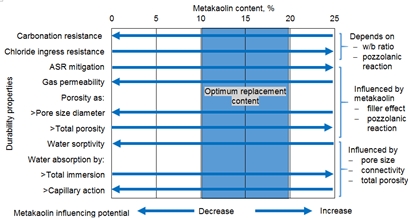Use of metakaolin as supplementary cementitious material in concrete, with focus on durability properties
DOI:
https://doi.org/10.21809/rilemtechlett.2019.94Keywords:
Metakaolin, Concrete penetrability, Alkali-silica reaction, CarbonationAbstract
Numerous research efforts on metakaolin as a supplementary cementitious material (SCM) have been undertaken in the past 20 years. This material, while relatively expensive mainly due to low production volumes worldwide, nevertheless has a significantly lower production cost than Portland cement. However, industry remains tentative in considering metakaolin in concrete. This paper takes the view that industry should consider investing in the production and application of metakaolin in appropriate concrete projects, particularly in aggressive environments where plain Portland cement may be inadequate, and where other SCMs may not readily be available. The main contribution of the paper is a global review of recent studies on the use of metakaolin in different types of concrete. This international experience is then compared with results from a study on the durability performance of metakaolin concrete using local materials in the Western Cape province of South Africa, as a means of concrete performance improvement. The study investigates concrete durability properties: penetrability (sorptivity, permeability, conductivity and diffusion), mitigation of Alkali-Silica Reaction (ASR), and carbonation resistance. The concretes were prepared with three water-binder ratios (0.4, 0.5 and 0.6), and with metakaolin replacement levels of 0% (control), 10%, 15% and 20%. Performance results show that, with increasing metakaolin content, the transport properties of concrete are considerably improved, ASR expansion due to a highly reactive local aggregate decreases to non-deleterious levels, while no detrimental effect on carbonation is observed. Thus, metakaolin could serve as a valuable SCM to enhance the durability performance of concrete in local aggressive environments.

Downloads
Published
How to Cite
Issue
Section
License
Authors retain copyright of the articles published in RILEM Technical Letters and grant the journal the right of first publication with open access. The work is simultaneously licensed under Creative Commons Attribution 4.0 International License (CC BY 4.0) that allows others to share and adapt the work under the following terms: 1) a proper attribution is given in a form of bibliographic record with the DOI link directing to RILEM Technical Letters; 2) a link to the license is provided; 3) the changes (if any) are indicated.









